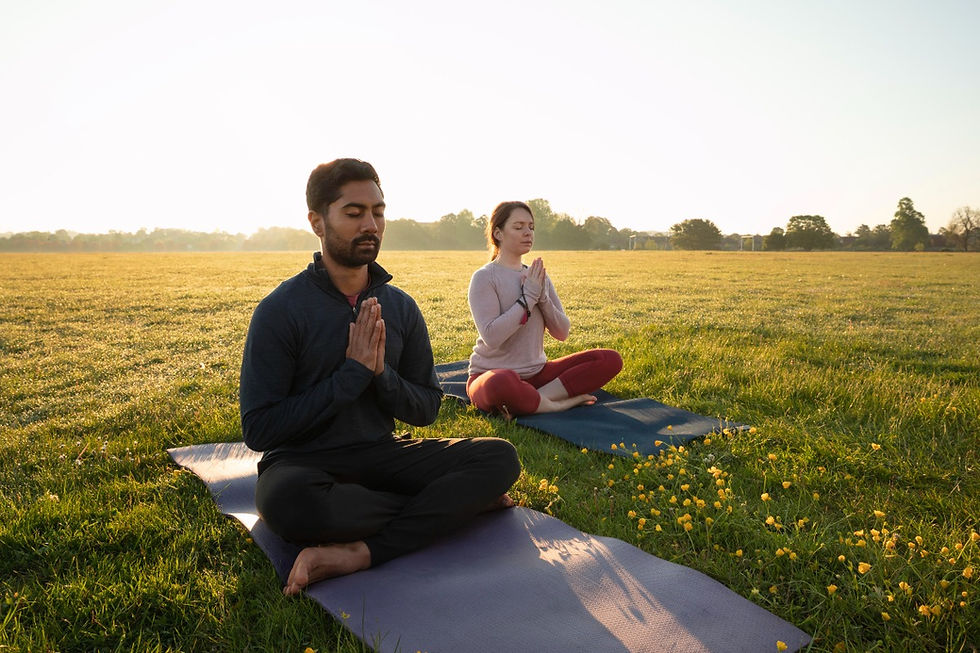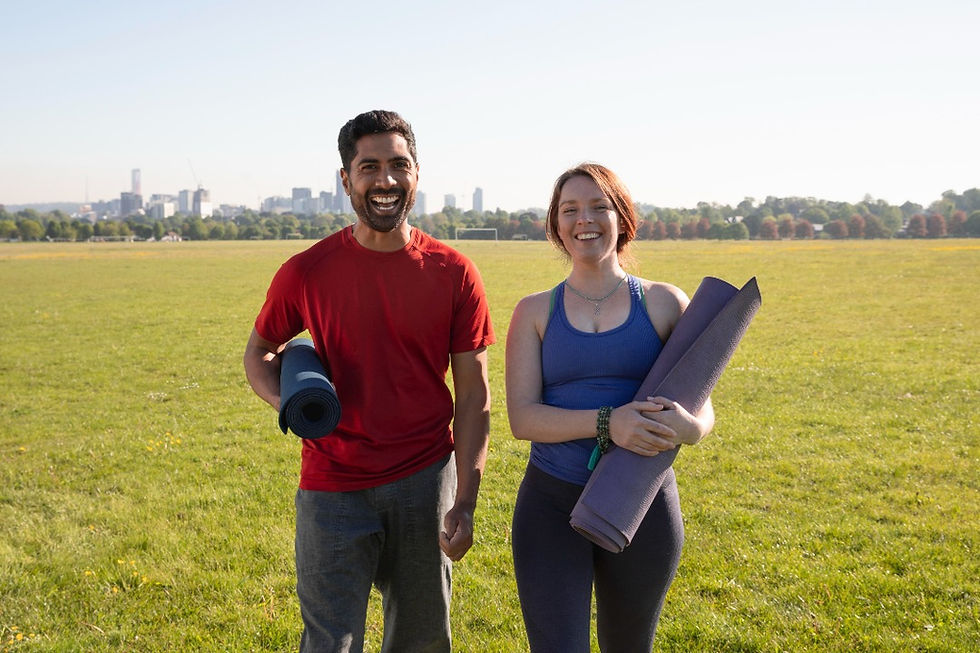Bhastrika Pranayama or Bellows Breath in Yoga - Steps & Benefits
- Aug 2, 2021
- 6 min read
Updated: Jan 11, 2022
Bhastrika Pranayama or Bellows Breath is used in yoga to kindle the inner fire and shake off sluggishness. It's a form of diaphragmatic yoga breathing for mental clarity and an energy boost.

The 'bellows' is a mechanical device you find in a blacksmith’s forge. This nifty device sucks in air from a hole at one end, compresses it with a valve, and expels a blast of air from the nozzle at the other end. It is used to stoke a fire to speed up combustion at the smithy's.
In yoga, Bhastrika materializes from Bhastra, the Sanskrit word for bellows. Except, in this case, your breathing apparatus is the bellows. The fire is the ‘Agni’ located at the navel point. Simply put, you use this yoga breathing method to stoke the 'inner fire' to create light and energy.
Other names: Bellows Breath, Bellows Breathing, Stimulating Breath, and Breath of Fire.
In Bhastrika Pranayama, a yogi uses deep and forced breathing to direct a blast of wind to the upper chest to stoke two fires – a) the digestive fire called Jatharagni and b) the inner fire that is associated with the mind. When done right, this simple yoga breathing technique can make you feel invigorated. It’s the same feeling you get after a good run or a workout.
TL;DR – Bhastrika is a yoga technique of deep and assertive nasal breathing with equal duration and intensity of inhalation and exhalation.
Bhastrika Pranayama- Step-by-Step Instructions
Before you start: Spread out a yoga mat and sit in any of the suitable postures for pranayama. We recommended the Lotus Posture or Thunderbolt Pose for this particular yoga breathing technique. There is something magical about the combination. Of course, you are free to sit cross-legged in Easy Pose or even on a chair with an acceptable posture.
The hands may form Chin Mudra, Vayu Mudra, Adi Mudra or Gyan Mudra.
Bellows Breathing: All you need to do is breath in and out vigorously with an even duration of inhalation of exhalation (1:1 ratio). Inhale forcefully by expanding the abdominal muscles and exhale vigorously by contracting the abdominal muscles. However, there is a little nuance to it.
All effort during Bhastrika should be felt in the diaphragm, chest, and abdomen. Since you are breathing forcefully, there will be a distinct sound. The sound should be similar to a bellows in action. If you are performing the pranayama correctly, that is.
Use the same force and count (duration) for inhalation and exhalation. For instance, if you start with 4 counts, inhalation and exhalation should have the same duration.
Beginners generally start with 6 to 10 cycles per minute and accomplished yogis can do 2 exhale-inhale cycles per second. Mastery of Bhastrika pranayama takes months (or years) of practice, so do not exceed your capacity and comfort.
Relax between sets: Beginners should place their palms (facing the sky) on the thighs and breath normally between sets. Intermediate practitioners can practice Ujjayi breathing between sets.
Follow up: You can attempt Kapalbhati after some rest. We also recommend following up Bellows breathing with Alternate Nostril Breathing. It is a classic pranayama combination.
Practice Tips: 5 Dos and Don'ts for Bhastrika Pranayama

DO 10 rounds per set. Generally, beginners can only do 5 to 8 rounds per set. Add no more than one round each day till you reach 10 per set. Rest for a bit and then proceed to the second set.
DON'T be in a hurry to ‘master’ Bhastrika because it is a forceful way of breathing. Overdoing it will exhaust you, which is the opposite effect considering it is supposed to do – energize you.
DO try to breathe in perfect rhythm for the entirety of your bellows breath practice. Don't add anything new until it feels effortless. Attempt advanced versions only after you are adept at contracting-releasing the abdominal muscles.
DON'T do fast-paced Bhastrika in warm weather and don't end your practice with it. Bellows breathing is used to rev up the lungs and increase oxygenation. It is always placed at the start of the practice and categorized as an energizing / warming pranayama.
DO Bhastrika pranayama for as long as you sound like a bellows. Stop when the “bellows sound” became weak or distorted. That’s your baseline capacity. There is a lot of disparity in the instructional information about how many rounds one should perform in one set. Yogis rightly states that you cannot put a number on it as each individual is different.
Safety and Precautions
Bhastrika pranayama contraindications include pregnancy, hernia, vertigo, high blood pressure (hypertension), respiratory diseases, and heart ailments. Refrain from practicing the pranayama during a fever and intestinal problems such as ulcers. Lastly, some people may experience headaches or migraines after Bhastrika pranayama. In that case, discontinue the practice and try again later. If headaches persist, consult a yoga instructor and/or your healthcare giver.
Bhastrika Benefits: Why Bellows Breathing is all the rage?

1. A preparatory practice for pranayama and meditation.
Yogis use the Bellows breathing at the beginning of their pranayama practice to attain clarity and vigor. It rouses the lungs, increases alertness, and energizes the mind and body. These qualities make it the ideal ‘wamp up’ before a session of pranayama and/or meditation.
2. Increases energy and oxygenation
The rousing of the lungs during Bellows breath leads to oxygenation, which in turn will improve the circulation of blood and prana to many organs and tissues in the body. This improved blood flow is also why it is said that Bhastrika can ‘energize’ the mind and body. A study[1] on athletes concluded that Bhastrika can enhance the efficiency of the lungs and deliver sufficient oxygen uptake. Other studies have shown that when done at a slow place, Bellows breathing can improve autonomic (ANS) function by stimulating the parasympathetic nervous system.
3. Strengthens digestion and tones the abdominal muscles
As you get better at Bhastrika, you will increase the speed of inhalation and exhalation. This creates rapid movement of the stomach i.e. the expansion and contraction of the stomach. In turn, it increases blood flow to the region, tones the abdominal muscles, encourages healthy bowel movement, and leads to the optimal functioning of the digestive system. The pranayama is also beneficial for those who suffer from acidity, flatulence (gas), or indigestion.
4. Strengthens lungs and relives Congestion
Bhastrika pranayama removes excess phlegm and relieves congestion in the nasal passages and the throat/chest region. It is prescribed (usually in combination with Kapalbhati Pranayama) to people who suffer from blocked sinuses. Another study[2] on the effects of Bhastrika and Anulom Vilom indicates that they can improve lung capacity and respiratory volume. The study also noted that an 8-week program can be helpful in improving physical performance.
5. Correct Dosha Imbalances
Bhastrika pranayama is said to correct imbalances in Vata, Pitta, and Kapha – the three doshas as per Ayurveda. A few rounds of Bhastrika every morning are one of the many ways to achieve and maintain the state of Tridosha – balance, and harmony of the three body humors.
6. Potential to reduce stress, anxiety, and depression.
A randomized control trial [3] in 2020 observed that one month of Bhastrika pranayama resulted in a significant decrease in anxiety and stress levels. They also noticed changes in the brain region that relates to emotional processing and is associated with negative emotions such as fear. That said, we do not endorse replacing any ongoing medical treatment with Bhastrika pranayama without consulting your healthcare giver and a yoga expert.
Ask the Expert: Bhastrika FAQ
When is the best time to do Bhastrika?
The early morning hours are the best time to do Bhastrika Pranayama. Start your pranayama routine with Bellows breath to shake off grogginess. It can achieve the same effects as a good, strong cup of coffee. Plus, it will work the intestines of those people who struggle with constipation or irregular bowel movement.
How many rounds of Bhastrika should beginners do?
One set (twenty rounds max.) of Bhastrika is recommended for beginners. Two sets are good for those who suffer from anxiety, low blood pressure, and Kapha dosha (as per Ayurveda). Once you are familiar with the practice, three sets of twenty rounds each can be performed. Additionally, you can perform more rounds in cold weather to generate heat in the body.
Who should avoid Bhastrika Pranayama?
Bhastrika is safe enough for most people. However, it should be avoided on a full stomach. Bhastrika also stimulates the nervous system and may prevent you from winding down if you do this pranayama too close to bedtime.
Stay the Course: Related Articles
References
1. Budhi, R. B., Payghan, S., & Deepeshwar, S. (2019). Changes in Lung Function Measures Following Bhastrika Pranayama (Bellows Breath) and Running in Healthy Individuals. International Journal of Yoga, 12(3), 233–239. https://doi.org/10.4103/ijoy.IJOY_43_18
2. Bal, B. S. (2010). Effect of Anulom Vilom and Bhastrika Pranayama on the vital capacity and maximal ventilatory volume. Journal of Physical Education and Sport Management, Vol.1(1), 11–15. https://doi.org/10.5897/JPESM.9000009
3. Novaes MM, Palhano-Fontes F, Onias H, Andrade KC, Lobão-Soares B, Arruda-Sanchez T, Kozasa EH, Santaella DF and de Araujo DB (2020) Effects of Yoga Respiratory Practice (Bhastrika pranayama) on Anxiety, Affect, and Brain Functional Connectivity and Activity: A Randomized Controlled Trial. Front. Psychiatry 11:467. doi: 10.3389/fpsyt.2020.00467

Comentários